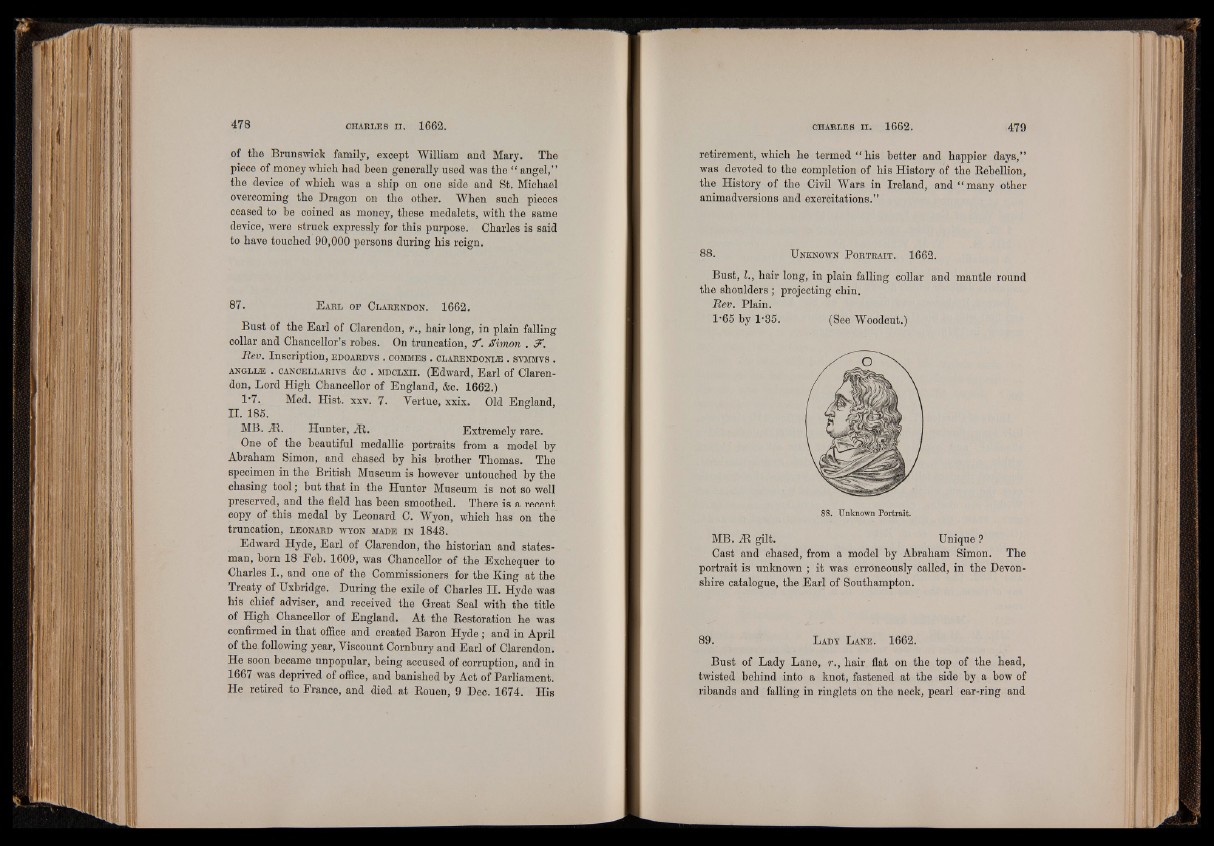
of the Brunswick family, except William and Mary. The
piece of money which had been generally used was the “ angel,”
the device of which was a ship on one side and St. Michael
overcoming the Dragon on the other. When such pieces
ceased to be coined as money, these medalets, with the same
device, were struck expressly for this purpose. Charles is said
to have touched 90,000 persons during his reign.
87. E a r l o f C la r en d o n . 1662.
Bust of the Earl of Clarendon, r., hair long, in plain falling
collar and Chancellor’s robes. On truncation, 7'. Simon . 3r.
Rev. Inscription, edoardvs . commes . c l a r e n d o n s . svmmvs .
a n g l l e . ca nc e lla r iv s &c . m d c l x i i. (Edward, Earl of Clarendon,
Lord High Chancellor of England, &c. 1662.)
1*7. Med. Hist. xxv. 7. Yertue, xxix. Old England,
II. 186.
MB. jit. Hunter, 2R. Extremely rare.
One of the beautiful medallic portraits from a model by
Abraham Simon, and chased by his brother Thomas. The
specimen in the British Museum is however untouched by the
chasing tool; but that in the Hunter Museum is not so well
preserved, and the field has been smoothed. There is a recent
copy of this medal by Leonard C. Wyon, which has on the
truncation, Leo n a rd wyon made in 1843.
Edward Hyde, Earl of Clarendon, the historian and statesman,
born 18 Feb. 1609, was Chancellor of the Exchequer to
Charles I., and one of the Commissioners for the King at the
Treaty of Uxbridge. During the exile of Charles II. Hyde was
his chief adviser, and received the Great Seal with the title
of High Chancellor of England. At the Restoration he was
confirmed in that office and created Baron Hyde ; and in April
of the following year, Viscount Cornbury and Earl of Clarendon.
He soon became unpopular, being accused of corruption, and in
1667 was deprived of office, and banished by Act of Parliament.
He retired to France, and died at Rouen, 9 Dec. 1674. His
retirement, which he termed “ his better and happier days,”
was devoted to the completion of his History of the Rebellion,
the History of the Civil Wars in Ireland, and “ many other
animadversions and exercitations.”
88. U n k n o w n P o r t r a i t . 1662.
Bust, I., hair long, in plain falling collar and mantle round
the shoulders ; projecting chin.
Rev. Plain.
l m65 by 1-35. (See Woodcut.)
8. Unknown Portrait.
MB. At gilt. Unique ?
Cast and chased, from a model by Abraham Simon. The
portrait is unknown ; it was erroneously called, in the Devonshire
catalogue, the Earl of Southampton.
89. L ady L a n e . 1662.
Bust of Lady Lane, r., hair flat on the top of the head,
twisted behind into a knot, fastened at the side by a bow of
ribands and falling in ringlets on the neck, pearl ear-ring and